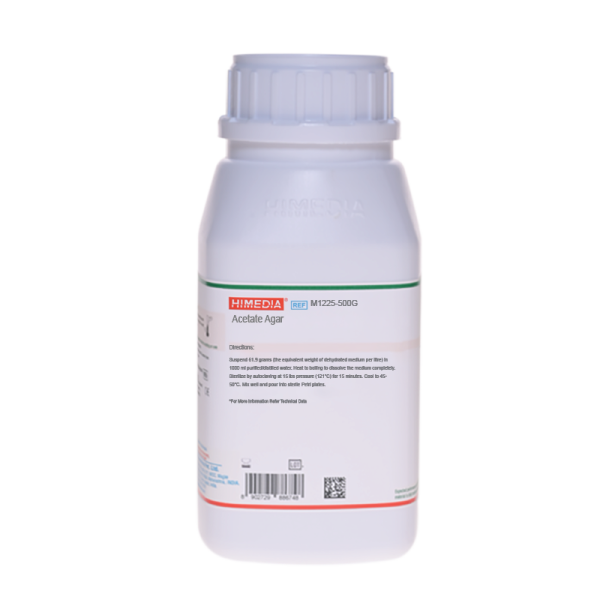 Your enquiry has been submitted
Your enquiry has been submitted
Acetate Agar
Intended Use:
Recommended for the isolation and cultivation of Leuconostoc and Pediococcus species.
Composition**
| Ingredients | Gms / Litre |
|---|---|
| Peptone | 5.000 |
| HM extract # | 5.000 |
| Yeast extract | 5.000 |
| Dextrose (Glucose) | 10.000 |
| Polysorbate 80 (Tween 80) | 0.500 |
| Sodium acetate trihydrate | 27.220 |
| Agar | 20.000 |
| Final pH (at 25°C) | 5.4±0.2 |
| Agar | 20.000 |
**Formula adjusted, standardized to suit performance parameters
# Equivalent to Meat extract
Directions
Suspend 61.9 grams (the equivalent weight of dehydrated medium per litre) of dehydrated medium in 1000 ml purified / distilled water. Heat to boiling to dissolve the medium completely. Sterilize by autoclaving at 15 lbs pressure (121°C) for 15 minutes. Cool to 45-50°C. Mix well and pour into sterile Petri plates.
Principle And Interpretation
Leuconostoc is a genus of gram-positive bacteria, which are heterofermentative and are able to produce dextran from sucrose. These are blamed for causing the stink when creating a sour dough starter. Some species are also capable of causing human infection (5). Pediococcus is a genus of gram-positive lactic acid bacteria, which are purely homofermentative. Pediococcus bacteria are usually considered contaminants of beer and wine although their presence is sometimes desired in beer styles such as Lambic. Certain Pediococcus isolates produce diacetyl, which gives a buttery or butterscotch aroma to some wines (such as Chardonnay) and a few styles of beer. Pediococcus species are often used in silage inoculants. Acetate agar was formulated by Whittenbury (6) and then modified by Keddie (3). Peptone, yeast extract, HM extract provide nitrogeneous and carbonaceous compounds, vitamins and all essential growth nutrients. Polysorbate 80 maintains the surface tension of the medium to the optimal level. Glucose is the energy source. Sodium acetate serves as a sole source of carbon.
Type of specimen
Food samples and Brewery Samples
Specimen Collection and Handling:
For food samples, follow appropriate techniques for sample collection and processing as per guidelines (4).
After use, contaminated materials must be sterilized by autoclaving before discarding.
Warning and Precautions :
Read the label before opening the container. Wear protective gloves/protective clothing/eye protection/ face protection. Follow good microbiological lab practices while handling specimens and culture. Standard precautions as per established guidelines should be followed while handling clinical specimens. Safety guidelines may be referred in individual safety data sheets.
Limitations :
- Individual organisms differ in their growth requirement and may show variable growth patterns on the medium.
- Each lot of the medium has been tested for the organisms specified on the COA. It is recommended to users to validate the medium for any specific microorganism other than mentioned in the COA based on the user's unique requirement.
Performance and Evaluation
Performance of the medium is expected when used as per the direction on the label within the expiry period when stored at recommended temperature.
Quality Control
Appearance: Light yellow to beige homogeneous free flowing powder
Gelling: Firm, comparable with 2.0% Agar gel.
Colour and Clarity of prepared medium: Yellow coloured clear to slightly opalescent gel forms in Petri plates
Reaction: Reaction of 6.19% aqueous solution at 25°C. pH : 5.4±0.2
pH: 5.20-5.60
Cultural Response: Cultural characteristics observed after an incubation at 25-30°C for 18-48 hours.
| Organism | Growth |
|---|---|
| Enterococcus faecalis ATCC 29212 (00087*) | none-poor |
| Leuconostoc mesenteroides ATCC 12291 | good-luxuriant |
| Pediococcus acidilactici ATCC 33314 | good-luxuriant |
Key: *Corresponding WDCM numbers.
Storage and Shelf Life
Store dehydrated and the prepared medium at 2-8°C. Use before expiry date on the label. On opening, product should be properly stored dry, after tightly capping the bottle in order to prevent lump formation due to the hygroscopic nature of the product. Improper storage of the product may lead to lump formation. Store in dry ventilated area protected from extremes of temperature and sources of ignition. Seal the container tightly after use. Product performance is best if used within stated expiry period.
Disposal
User must ensure safe disposal by autoclaving and/or incineration of used or unusable preparations of this product. Follow established laboratory procedures in disposing of infectious materials and material that comes into contact with sample must be decontaminated and disposed of in accordance with current laboratory techniques (1,2).
Reference
- Isenberg, H.D. Clinical Microbiology Procedures Handbook 2nd Edition.
- Jorgensen, J.H., Pfaller, M.A., Carroll, K.C., Funke, G., Landry, M.L., Richter, S.S and Warnock., D.W. (2015) Manual of Clinical Microbiology, 11th Edition. Vol. 1.1.
- Keddie R. M., 1951, Proceed. Soc. Appl. Bacteriol., 14:157
- Salfinger Y., and Tortorello M.L., 2015, Compendium of Methods for the Microbiological Examination of Foods, 5th Ed., American Public Health Association, Washington, D.C.
- Vagiakou-Voudris E., Mylona-Petropoulou D., Kalogeropoulou E., Chant zis A., Chini S., Tsiodra P., Malamou-Lada E., J. Infect. Dis. 2002;34(10):766-7
- Whittenbury R., 1965 b, J. Gen. Microbiol., 40:97.
| Product Name | Acetate Agar |
|---|---|
| SKU | M1225 |
| Product Type | Regular |
| Physical Form | Powder |
| Origin | Animal |
| Packaging type | HDPE |
| References | 1. Vagiakou-Voudris E., Mylona-Petropoulou D., Kalogeropoulou E., Chant zis A., Chini S., Tsiodra P., Malamou-Lada E.,J. Infect. Dis. 2002;34(10):766-7 |
| Customized Product Available | No |





